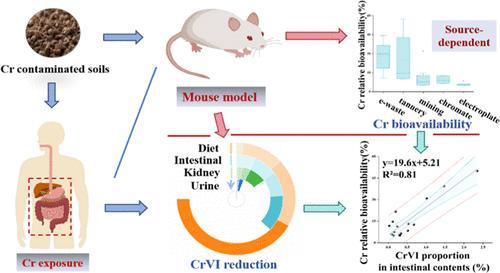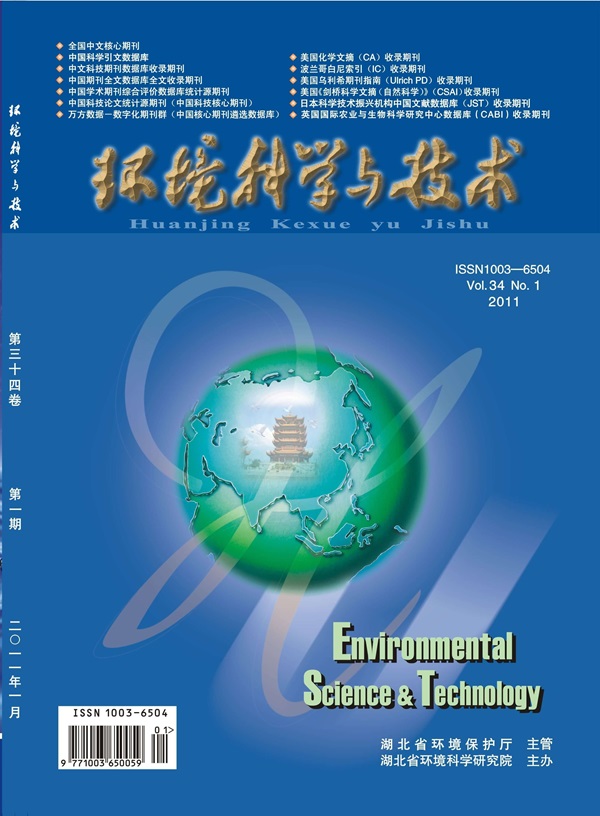Chromium Oral Bioavailability in 16 Contaminated Soils from Different Sources: Mouse Model Development and Cr Speciation in Soil and Mouse Tissues
IF 11.3
1区 环境科学与生态学
Q1 ENGINEERING, ENVIRONMENTAL
引用次数: 0
Abstract
Soil contamination by chromium (Cr) has attracted much public attention due to its ubiquity in the environment and toxicity to humans, with hexavalent CrVI being more toxic and mobile than trivalent CrIII. In this study, 16 soils contaminated from different sources were chosen to determine their Cr accumulation in mouse tissues and changes in Cr speciation in soils, and mouse intestinal contents, organs and excreta based on a steady-state mouse model. The Cr accumulation in mouse organs after exposing to CrVI was 1.6–2.6 fold greater than those exposing to CrIII. Further, Cr relative bioavailability (RBA) was measured using a mouse urinary excretion bioassay. Results show that Cr via oral digestion was mainly accumulated in the kidneys, with Cr-RBA in soils being 5.12–50.0%, averaging 15.6%. Besides soil properties, variation in Cr-RBA also depended on its contamination sources, with soils near electronic waste dismantling and tannery sites showing greater values. Further, instead of the CrVI contents in contaminated soils, Cr-RBA was closely related to the unreduced CrVI contents in mouse intestines, with 90.1% of CrVI being reduced before its absorption. This study helps to evaluate the health risks associated with Cr-contaminated soils by measuring Cr-RBA via a newly developed mouse model and its influence by Cr speciation. Our data suggest a potential risk associated with incidental exposure to Cr-contaminated soils via an oral pathway.

铬在16种不同来源污染土壤中的口服生物利用度:小鼠模型发育及土壤和小鼠组织中铬的形态形成
铬(Cr)因其在环境中的普遍存在和对人体的毒性而引起了人们的广泛关注,六价CrVI比三价CrIII更具毒性和移动性。本研究选择了16种不同污染来源的土壤,在小鼠稳态模型的基础上,测定了土壤、肠道内容物、脏器和排泄物中Cr在小鼠组织中的积累和形态变化。CrVI暴露后小鼠器官中Cr的积累量是CrIII暴露小鼠的1.6 ~ 2.6倍。此外,Cr的相对生物利用度(RBA)采用小鼠尿排泄生物测定法测定。结果表明,Cr主要通过口腔消化在肾脏中积累,土壤中Cr- rba为5.12 ~ 50.0%,平均为15.6%。除土壤性质外,Cr-RBA的变化还取决于其污染源,电子废物拆解和制革厂附近的土壤显示出更高的值。此外,Cr-RBA与小鼠肠道中未还原的CrVI含量密切相关,而不是污染土壤中的CrVI含量,90.1%的CrVI在被吸收之前被还原。本研究通过新开发的小鼠模型测量Cr- rba及其受Cr物种形成的影响,有助于评估与Cr污染土壤相关的健康风险。我们的数据表明,通过口腔途径偶然暴露于铬污染的土壤有潜在的风险。
本文章由计算机程序翻译,如有差异,请以英文原文为准。
求助全文
约1分钟内获得全文
求助全文
来源期刊

环境科学与技术
环境科学-工程:环境
CiteScore
17.50
自引率
9.60%
发文量
12359
审稿时长
2.8 months
期刊介绍:
Environmental Science & Technology (ES&T) is a co-sponsored academic and technical magazine by the Hubei Provincial Environmental Protection Bureau and the Hubei Provincial Academy of Environmental Sciences.
Environmental Science & Technology (ES&T) holds the status of Chinese core journals, scientific papers source journals of China, Chinese Science Citation Database source journals, and Chinese Academic Journal Comprehensive Evaluation Database source journals. This publication focuses on the academic field of environmental protection, featuring articles related to environmental protection and technical advancements.
 求助内容:
求助内容: 应助结果提醒方式:
应助结果提醒方式:


